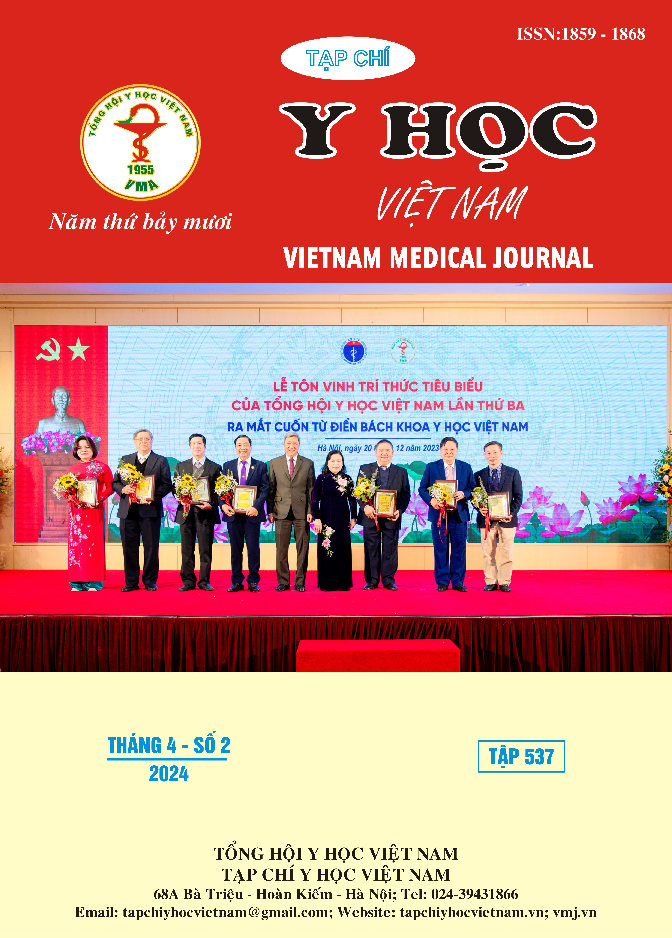INVESTIGATION OF THE ANTIOXIDANT EFFECT OF SECONDARY METABOLITES ISOLATED FROM CANNA INDICA L. RHIZOMES FOR THE TREATMENT AND PREVENTION OF HEART DISEASES
Main Article Content
Abstract
Canna indica L. is a potential medicinal plant for the treatment and prevention of heart diseases. This study evaluated for the first time the antioxidant effect of secondary metabolites isolated from Canna indica L. rhizomes. The DPPH and ABTS assays were performed for 8 compounds including canindicoside A (1), canindicoide B (2), methyl ester S-(-)-rosmarinic acid (3), isorinic acid (4), stiryst-4-ene-3,6-dione (5), 6β-hydroxystigmast-4-en-3-one (6), ent-kaur-15-ene-19-al-17-oic acid (7) and 16α-hydro-19-ol-ent-kauran-17-oic acid (8). The results showed that compound 3 exhibited the strongest antioxidant effect, followed by compounds 4, 1, 7 and 2. Compound 6 had the lowest antioxidant effect. However, compounds 5 and 8 did not show any antioxidant activity. C. indica rhizome could be a potential natural resource for the investigation of bioactive molecules and the development of dietary supplement products to treat and prevent oxidative stress-related diseases.
Article Details
Keywords
Antioxidant, Canna indica, phytochemicals, rhizome
References
2. Oana, Y.,Balakyz ,A. R., Ahmad, F. M., Babagana C.,Daniela S. R. (2023). Oxidative stress, free radicals and antioxidants: potential crosstalk in the pathophysiology of human diseases, Frontiers in Chemistry. 11(2023):1158198.
3. Al-Snafi, A.S., 2015. Bioactive components and pharmacological effects of Canna indica - an overview. Int. J. Pharmacol. Toxicol. 5(2015): 71–75.
4. Kumbhar, S.T., Patil, S.P., Une, H.D. (2018). Phytochemical analysis of Canna indica L. roots and rhizomes extract. Biochem. Biophys. Rep. 16(2018): 50–55.
5. Nguyen, T. V. A, Nguyen, T. M. H., Le, H. L., Bui, D. H. (2023). Potential antithrombotic effect of two new phenylpropanoid sucrose esters and other secondary metabolites of Canna indica L. rhizome. Nat Prod Res (2023): 1-9.
6. Nguyen, T. V. A, Nguyen, T. M. H., Le, H. L., Bui, D. H. (2023). Antithrombotic Activity of the Steroids and ent‑Kaurane Diterpenoids from Canna indica Rhizomes. Rev Bras Farmacgn (2023).
7. Le, H. L., Nguyen, T. M. H., Vu, T. T., Nguyen, T. T. O., Duong, T. L. H., Le, N. T., Nguyen, V. H., Nguyen, T. V. A. (2022). Potent antiplatelet aggregation, anticoagulant and antioxidant activity of aerial Canna x generalis L.H Bailey & E.Z Bailey and its phytoconstituents. S. Afr. J. Bot. 147(2023): 882-893.
8. Indrayan, A. K., Bhojak, N. K., Kumar, N., Shatru, A. and Gaura A. (2011). Chemical composition and antimicrobial activity of the essential oil from the rhizome of Canna indica Linn. Indian Journal of Chemistry. 50B(2011): 1136-1139.
9. Ayusman, S., Duraivadivel, P., Gowtham, H. G., Sharma, S Hariprasad, P. Bioactive constituents, vitamin analysis, antioxidant capacity and α-glucosidase inhibition of Canna indica L. rhizome extracts. Food Biosci. 35(2020): 100544


